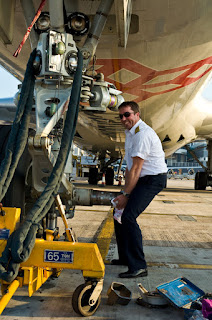hello!
i do not consider my blog political therefore no comments about the terror in france.
my topic today is changing tires on big aircraft. unknown to most bigger aircraft carry a spare tire, just like a car, hidden somewhere in the belly, usually in the back. while also carrying some other spares like special tools, oil for replenishment and a few smaller parts, all together called the flyaway -kit by Boeing, we do not carry the jacklift to actually change a tire or other heavy tools.
we rely on getting this tools at the aiport.
next problem is the weight - while it's not a major problem to change the nosewheels, it can be changing a body- or wing-gear tyre in the back, where the majority of the weight is resting. a typical hydraulic/pneumatic jack can lift 65 metric tonnes, while the aircraft (747-8) can weigh something inbetween the empty weight of about 196 t and the full take-off-weight of 444 t. so you think of 44 t resting on the nosewheels and 100 t on each main gear truck, exceeding the capabilities of the jack.
unlaoding the cargo becomes necessary, creating some delay...
sidenote: we also have a limit on the differential tire-pressure on one axle, if it is exceeded due to a completly flat tire we need to check/change the whole axle because it may be bent! tire pressure and brake temperature on the 747-8 are monitored constantly, so even if we have a slow deflation on a tire in flight we can see that in the cockpit and advise ground staff at the destination to prepare a pit stop for a new tire.
a speciality of the 747-8 is the possibility to mount 747-400 tires on the nosewheel if both of them are replaced. there are steel-adaptors in the fly-away kit to mount them. -400 tyres are a little bit more rounded on the profile, while the -8 tyres you can see on the pictures have a little edge on each side of the profile and can carry a little bit heavier load.
-8 tyres also are inflatet to a slightly higher pressure increasing the needed PCN or Pavement-Classification-Number on the airports.
the PCN is measured by drilling samples on airport movement surfaces, it should always be higher than the ACN, you guessed it - the Aircraft-Classification-Number.
if the PCN is not high enough it basically means the aircraft will sink into the asphalt, the possibility of a truck or car to drive on a surface doesn't mean anything to us, the 747 can still sink into weaker asphalt or concrete, therefore we watch our movements very carefully.
thanks for reading, was a little bit technical today, here are some pictures of a double nose-wheel change at hongkong airport, it took 3 hours to complete....
brgds - nuck







No comments:
Post a Comment